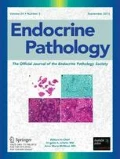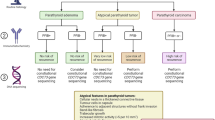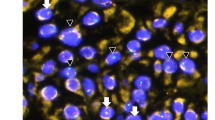Abstract
Parathyroid carcinoma has always been difficult to diagnose pathologically. In fact, most parathyroid tumors which are classified as carcinoma do not recur after excision, and most parathyroid tumors which actually metastasize or recur repeatedly in the neck are not recognized as malignant at first presentation. In 2002, germline HRPT2 (also known as CDC73) mutation was reported as the cause of hyperparathyroidism-jaw tumor (HPT-JT) syndrome, an autosomal dominant hereditary tumor syndrome associated with a lifetime risk of parathyroid carcinoma approaching 15 %. Subsequently, bi-allelic inactivation or mutation of HRPT2 has been reported in the majority of parathyroid carcinomas that actually behave in a malignant manner but very rarely in sporadic benign parathyroid disease. Furthermore, germline testing for HRPT2 mutation in patients presenting with parathyroid carcinoma often identifies occult HPT-JT syndrome even in the absence of a family history or other syndromic manifestations. HRPT2 mutation testing is not readily available, and loss of expression of parafibromin (the protein encoded by HRPT2) as determined by immunohistochemistry has been used as a surrogate marker of HRPT2 mutation. Immunohistochemistry for parafibromin can be technically difficult and has been deployed by different investigators with variable enthusiasm and success. However, proponents have found immunohistochemistry for parafibromin useful to definitively confirm a pathological diagnosis of parathyroid carcinoma, predict a worse outcome in definite parathyroid carcinomas, triage formal genetic testing for HPT-JT syndrome, and predict the outcome of histologically atypical parathyroid adenomas.

Similar content being viewed by others
References
Lee PK, Jarosek SL, Virnig BA, et al. Trends in the incidence and treatment of parathyroid cancer in the United States. Cancer 109:1736-1741, 2007
Brown S, O'Neill C, Suliburk J, et al. Parathyroid carcinoma: increasing incidence and changing presentation. ANZ J Surg 81:528-32, 2011
Schantz A, Castleman B Cancer 31:600-605, 1973
DeLellis RA, Lloyd RV, Heitz PU, et al. World Health organization classification of tumours Pathology and Genetics: Tumours of Endocrine Organs IARC Press Lyon 2004
Sandelin K, Tullgreen O, Farnebo LO. Clinical course of metastatic parathyroid carcinoma World J Surg 18:594-598, 1994
Ippolito G, Palazzo FF, Sebag F, et al. Intraoperative diagnosis and treatment of parathyroid cancer and atypical parathyroid adenoma British Journal of Surgery 94:566-570, 2007
Shane E Clinical review 122: parathyroid carcinoma J Clin Endocrinol Metabl 86:485-493, 2001
Obara T, Fujimoto Y Diagnosis and treatment of patients with parathyroid carcinoma. An update and review. World J Surg 15:738-744, 1991
Ishida T, Yokoe T, Izuo M Nationwide survey of parathyroid operations in Japan (1980-1989): Endocrine Surgery (Tokyo) 8:37, 1991
Favia G, Lumachi F, Polistina F et al. Parathyroid carcinoma: sixteen new cases and suggestions for correct management World J Surg 22:1225-1230, 1998
Fujimoto Y, Obara T, Ito Y, et al. Localization and surgical resection of metastatic parathyroid carcinoma World J Surg 10:539, 1986
Frayha RA, Nassar VH, Dagher F, Salti IS. Familial parathyroid carcinoma J Med Liban 25:299-309, 1972
Mallette LE, Bilezikian JP, Ketcham AS, Aurbach GD. Parathyroid carcinoma in familial hyperparathyroidism. Am J Med 57:642-8, 1974
Leborgne J, Le Neel JC, Buzelin F, Malvy P Familial cancer of the parathyroid glands. Importance of angiography in the diagnosis of regional recurrences. Considerations on 2 cases. J Chir (Paris) 109:315-26, 1975
Dinnen JS, Greenwoood RH, Jones JH, et al. Parathyroid carcinoma in familial hyperparathyroidism. J Clin Pathol 30:966-75, 1977
Smith JF, Coombs RGH Histological diagnosis of carcinoma of the parathyroid glandJ Clin Pathol 37:1370-137, 1984
Carpten JD, Robbins Cm, Villablanca A HRPT2, encoding parafibromin, is mutated in hyperparathyroidism-jaw tumor syndrome Nature Genetics 32:676-680, 2002
Howell VM, Haven CJ, Kahnoski K et al. HRPT2mutations are associated with malignancy in sporadic parathyroid tumours J Med Genet 40:657-663, 2003
Shattuck T, Stiina V, Obara T et al. Somatic and Germ-line mutations of the HRPT2 gene in sporadic parathyroid carcinoma New England Journal of Medicine 349:1722-1729, 2003
Cetani F, Pardi E, Borsari S, et al. Genetic Analyses of HRPT2 gene in primary hyperparathyroidism: Germline and Somatic Mutations in Familial and Sporadic Parathyroid Tumours Journal of Clinical Endocrinology and Metabolism 89:5583-5591, 2004
Kresbs L , Shattuck TM, Arnold A HRPT mutation analysis of typical sporadic parathyroid adenomas Journal of Clinical Endocrinology and Metabolism 90:5015-5017, 2005
Marsh DJ, Hahn MA, Howell VM, Gill AJ Molecular diagnosis of primary hyperparathyroidism in familial cancer syndromes Expert Opinion in Medical Diagnostics 1:377-92, 2007
Bricaire L, Odou MF, Cardot-Bauters C, et al. Frequent large germline HRPT2 deletions in a French National cohort of patients with primary hyperparathyroidism. J Clin Endocrinol Metab. 98:E403-8, 2013
Tan M-H, Morrison C, Wang P, et al. Loss of parafibromin immunoreactivity is a distinguishing feature of parathyroid carcinoma Clin Cancer Res 10:6629-6637, 2004
Gill AJ, Clarkson A, Gimm O, et al. Loss of nuclear expression of parafibromin distinguishes parathyroid carcinomas and Hyperparathyroidsim-Jaw Tumor (HPT-JT) syndrome related adenomas from sporadic parathyroid adenomas and hyperplasias American Journal of Surgical Pathology 30:1140-1149, 2006
Meyer-Rochow GY, Alvarado R, Sywak MS, et al. Intraoperative diagnosis and treatment of parathyroid cancer and atypical parathyroid adenoma British Journal of Surgery 94:1044, 2007
Howell VM, Gill AJ, Clarkson A, et al. Accuracy of combined protein gene product 9.5 and parafibromin markers for immunohistochemical diagnosis of parathyroid carcinoma Journal of Clinical Endocrinology and Metabolism 94:434-441, 2009
Wang O, Wang C, Nie M, et al. Novel HRPT2/CDC73 gene mutations and loss of expression of parafibromin in Chinese patients with clinically sporadic parathyroid carcinomas. PLoS One. 7(9):e45567, 2012
Wang O, Wang CY, Shi J, et al. Expression of Ki-67, galectin-3, fragile histidine triad, and parafibromin in malignant and benign parathyroid tumors. Chin Med J (Engl) 125:2895-901, 2012
Lim S, Elston MS, Gill AJ, et al. Metastatic parathyroid carcinoma initially misdiagnosed as parathyroid adenoma: the role of parafibromin in increasing diagnostic accuracy. Intern Med J 41:695-9, 2011
Kim HK, Oh YL, Kim SH, et al. Parafibromin immunohistochemical staining to differentiate parathyroid carcinoma from parathyroid adenoma. Head Neck 34:201-6, 2012
Juhlin CC, Nilsson IL, Johansson K, et al. Parafibromin and APC as screening markers for malignant potential in atypical parathyroid adenomas. Endocr Pathol 21:166-77, 2010
Juhlin CC, Villablanca A, Sandelin K, et al. Parafibromin immunoreactivity: its use as an additional diagnostic marker for parathyroid tumor classification. Endocr Relat Cancer. 14:501-12, 2007
Cetani F, Ambrogini E, Viacava P, et al. Should parafibromin staining replace HRTP2 gene analysis as an additional tool for histologic diagnosis of parathyroid carcinoma? Eur J Endocrinol 156:547-54, 2007
Witteveen JE, Hamdy NA, Dekkers OM, et al. Downregulation of CASR expression and global loss of parafibromin staining are strong negative determinants of prognosis in parathyroid carcinoma. Mod Pathol. 24:688-97, 2011
Cabané T, Patricio, Gac E, et al. Detección inmunohistoquímica de parafibromina en patología de paratiroides. Revista chilena de cirugía, 65:20-24, 2013
Guarnieri V, Battista C, Muscarella LA et al. CDC73 mutations and parafibromin immunohistochemistry in parathyroid tumors: clinical correlations in a single-centre patient cohort Cellular Oncology 35:411-422, 2012
DeLellis RA, Mazzaglia P, Mangray S. Primary hyperparathyroidism: a current perspective. Arch Pathol Lab Med. 132:1251-62, 2008
Krujiff S, Sidhu SB, Sywak MS, et al. Negative parafibromin staining predicts malignant behaviour in atypical parathyroid adenomas Annals of Surgical Oncology Oct 1 [epub ahead of print]
Cetani F, Banti C, Pardi E, et al. CDC73 mutational status and loss of parafibromin in the outcome of parathyroid cancer. Endocr Connect. 28:186-95, 2013
M.S. Sarquis, L.G. Silveira, F.J. Pimenta, et al., Familial hyperparathyroidism: surgical outcome after 30 years of follow-up in three families with germline HRPT2 mutations, Surgery 143:630–640, 2008
Conflict of Interest
The author reports no conflict of interest.
Author information
Authors and Affiliations
Corresponding author
Rights and permissions
About this article
Cite this article
Gill, A.J. Understanding the Genetic Basis of Parathyroid Carcinoma. Endocr Pathol 25, 30–34 (2014). https://doi.org/10.1007/s12022-013-9294-3
Published:
Issue Date:
DOI: https://doi.org/10.1007/s12022-013-9294-3




